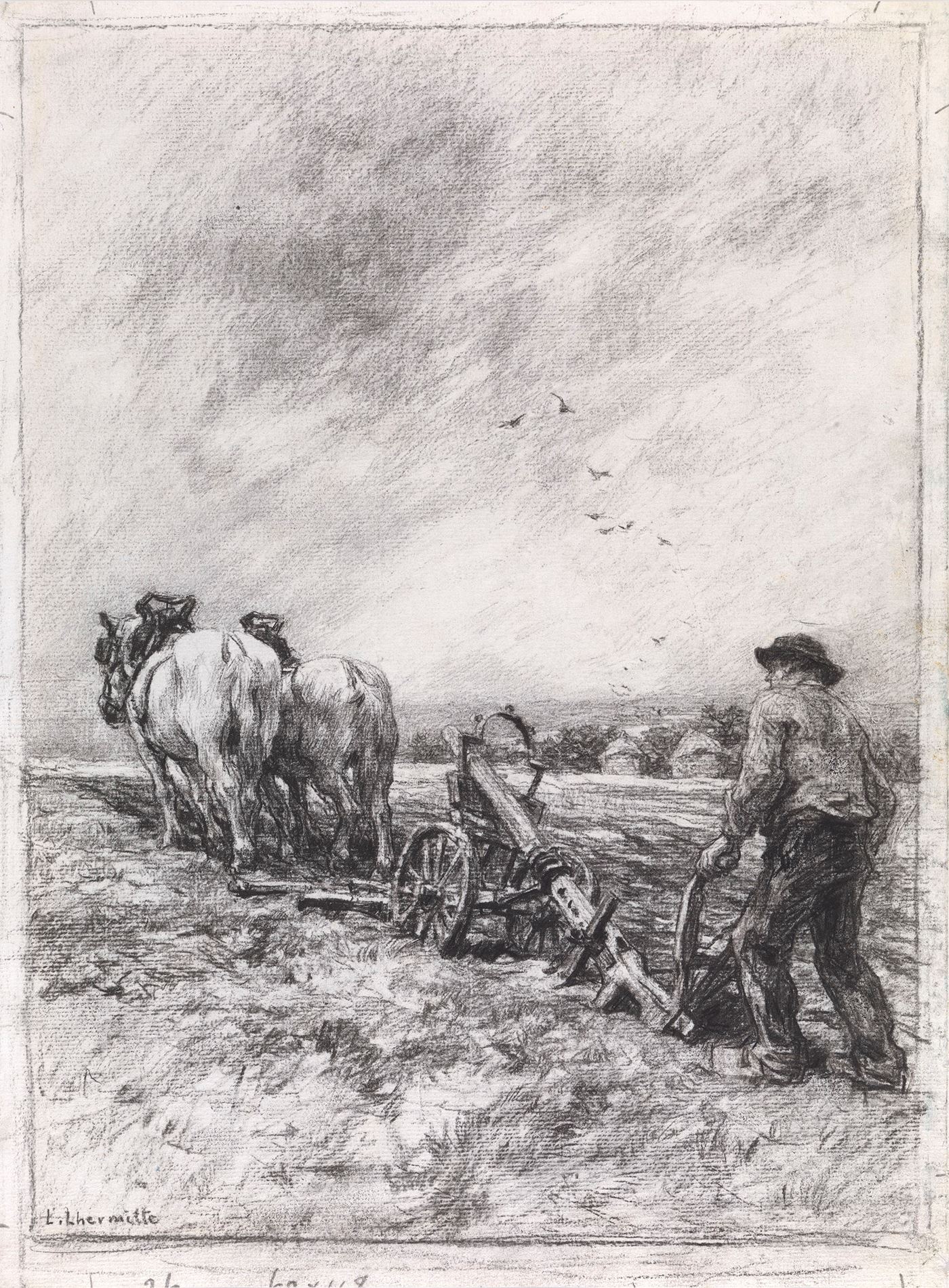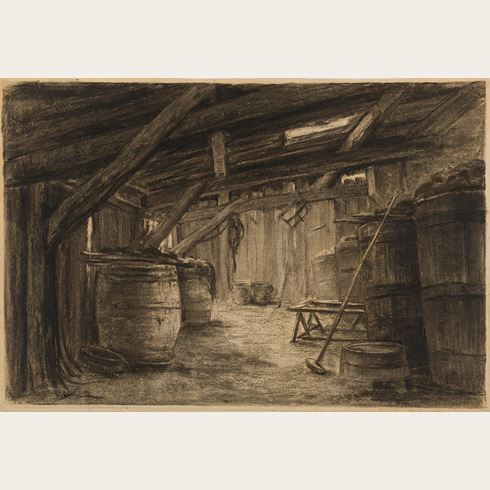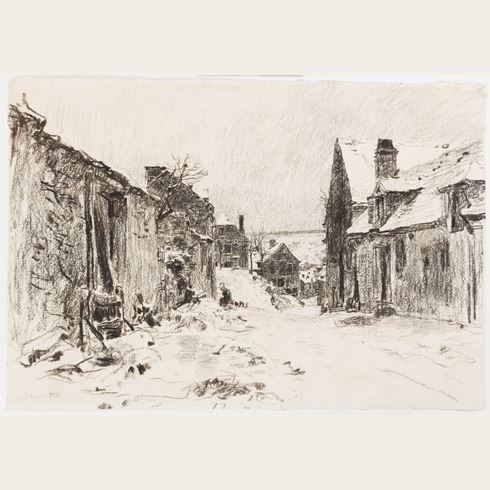Léon Augustin LHERMITTE
(Mont-Saint-Père 1844 - Paris 1925)
Ploughing (Le Labourage)
Sold
Charcoal and pencil, with framing lines in pencil.
Signed L. Lhermitte at the lower left.
393 x 295 mm. (15 1/2 x 11 5/8 in.) [sheet]
Signed L. Lhermitte at the lower left.
393 x 295 mm. (15 1/2 x 11 5/8 in.) [sheet]
Drawn in November 1886, this is one of a series of 128 charcoal drawings commissioned from Lhermitte to serve as illustrations for the French poet and novelist André Theuriet’s book La Vie rustique, published in 1888, and in an English translation in America in 1896. Theuriet had originally conceived the book as a collaboration with the painter Jules Bastien-Lepage, and on the latter’s death in 1884, he turned to Lhermitte. La Vie rustique was a detailed description of peasant life, and also served as a sort of elegy for the daily rituals of rustic life, which the author feared would be lost with the advent of industrialisation and modernity. As Theuriet noted in the introduction to the book, ‘We have tried religiously to collect the relics of the customs, the faces, and landscapes which are likely to disappear, and we shall be abundantly rewarded for our efforts if we have thus been able to preserve to posterity the picture of a world and a nature which they may never know.’
The scholar John House adds that, ‘André Theuriet’s La vie rustique, published in 1888, was a lavish presentation of a way of life that he saw as disappearing. After a brief invocation of the harshness of peasant labour, Theuriet turned to a paean to the ‘charm’ and ‘picturesque qualities’ that artists and poets found in the countryside. His book was a monument to what he saw as the imminent loss of this lifestyle, already foreshadowed by the invasion of industry into the environs of Paris, ‘diminished, vulgarised, polluted by the factories’. As he presents it, though, Theuriet seems to be mourning the loss of a mythic image rather than of any social reality.’
This study for Ploughing (Le Labourage) from La Vie rustique is a superb example of Lhermitte’s charcoal drawings from the height of his career. The composition is derived from that of another, slightly larger fusain, horizontal in orientation, that the artist had produced a year earlier to illustrate the month of March; part of a series of twelve drawings representing the months of the year that were published in Le Monde illustré in 1885. Both the present sheet and the horizontal composition of the previous year were drawn at the farm of Ru Chailly in the village of Fossoy, near his native Mont-Saint-Père in Picardy, where Lhermitte often worked.
The artist later returned to this composition, albeit in a horizontal format, some twenty-five years later, in a large painting of 1911 that was exhibited at the Salon des Beaux-Arts of that year. A pastel study of two plough horses, formerly in a private collection and sold at auction in 2002, may be related to the 1911 painting.
All 128 of Lhermitte’s drawings for La Vie rustique, including the present sheet, were exhibited in November 1887 at the Parisian offices of the publishers H. Launette et Cie., who retained ownership of the drawings. Only a handful of the fusains by Lhermitte for La Vie rustique have appeared on the art market in recent years, including Haymaking (Fenaison), which was sold at auction in 1992, Picking Lily of the Valley (Cueillette du muguet), which appeared at auction in 1996, and At the Well (À la fontaine), sold at auction in 2005. Perhaps the closest in style and composition to the present sheet, however, is the charcoal drawing for The Sower (Le semeur), which was sold at auction in New York in 2000 and again in 2008.
The present sheet may be regarded as one of the finest of Lhermitte’s series of illustrations for La Vie rustique, and serves to underline Richard Thomson’s apposite comments on the artist: ‘His draughtsmanship has a sureness, a probity even, which gives his compositions a resolute authority...his pastels and justly celebrated fusains are handled with an impressive sensitivity to light and atmosphere.’
The scholar John House adds that, ‘André Theuriet’s La vie rustique, published in 1888, was a lavish presentation of a way of life that he saw as disappearing. After a brief invocation of the harshness of peasant labour, Theuriet turned to a paean to the ‘charm’ and ‘picturesque qualities’ that artists and poets found in the countryside. His book was a monument to what he saw as the imminent loss of this lifestyle, already foreshadowed by the invasion of industry into the environs of Paris, ‘diminished, vulgarised, polluted by the factories’. As he presents it, though, Theuriet seems to be mourning the loss of a mythic image rather than of any social reality.’
This study for Ploughing (Le Labourage) from La Vie rustique is a superb example of Lhermitte’s charcoal drawings from the height of his career. The composition is derived from that of another, slightly larger fusain, horizontal in orientation, that the artist had produced a year earlier to illustrate the month of March; part of a series of twelve drawings representing the months of the year that were published in Le Monde illustré in 1885. Both the present sheet and the horizontal composition of the previous year were drawn at the farm of Ru Chailly in the village of Fossoy, near his native Mont-Saint-Père in Picardy, where Lhermitte often worked.
The artist later returned to this composition, albeit in a horizontal format, some twenty-five years later, in a large painting of 1911 that was exhibited at the Salon des Beaux-Arts of that year. A pastel study of two plough horses, formerly in a private collection and sold at auction in 2002, may be related to the 1911 painting.
All 128 of Lhermitte’s drawings for La Vie rustique, including the present sheet, were exhibited in November 1887 at the Parisian offices of the publishers H. Launette et Cie., who retained ownership of the drawings. Only a handful of the fusains by Lhermitte for La Vie rustique have appeared on the art market in recent years, including Haymaking (Fenaison), which was sold at auction in 1992, Picking Lily of the Valley (Cueillette du muguet), which appeared at auction in 1996, and At the Well (À la fontaine), sold at auction in 2005. Perhaps the closest in style and composition to the present sheet, however, is the charcoal drawing for The Sower (Le semeur), which was sold at auction in New York in 2000 and again in 2008.
The present sheet may be regarded as one of the finest of Lhermitte’s series of illustrations for La Vie rustique, and serves to underline Richard Thomson’s apposite comments on the artist: ‘His draughtsmanship has a sureness, a probity even, which gives his compositions a resolute authority...his pastels and justly celebrated fusains are handled with an impressive sensitivity to light and atmosphere.’
Léon Augustin Lhermitte studied at the École Imperiale du Dessin, and exhibited for the first time at the Salon of 1864. In 1868 he visited London, and in 1874 won a third-class medal at the Salon for his painting The Harvest. It was also in 1874 that Lhermitte spent several months working in Brittany. He was to return frequently over the next five years, during which time he showed Breton subjects at the Salon. In 1882 he achieved a considerable measure of success with the exhibition of his painting The Paying of the Harvesters, which was purchased by the State on the opening day of the Salon. From this point onwards he began to concentrate on depictions of rural and peasant life, centred on his native town of Mont-Saint-Père, on the banks of the Marne river in Picardy. In 1887 Lhermitte signed a contract with the gallery Boussod, Valadon & Cie. which gave them the exclusive rights to his paintings and pastels, though not his drawings. He enjoyed considerable commercial and critical success throughout his long career, and his paintings and drawings of daily life in the countryside were especially popular with British and American collectors. As one scholar has noted, ‘To Lhermitte, rustic activity embodied dignity, for he believed workers in the fields seldom complained about their lot in society...Lhermitte fabricated a serene and peaceful image of rustic life that competently conveyed an idyllic vision to his highly receptive audience.’ In 1890 he began exhibiting annually at the newly-established Société Nationale des Beaux-Arts, where he was given the honour of a retrospective exhibition in 1924, the year before his death. Lhermitte left a thorough record of his output – of paintings, watercolours, drawings and pastels - in notebooks that he kept between 1863 and 1897.
As a draughtsman, Lhermitte produced mainly pastels and charcoal drawings, for which he was very highly regarded. The former were much sought-after, and were exhibited yearly at the Société des Pastellistes and sold through his dealers Boussod & Valadon. His charcoal drawings were also exhibited widely as independent works, in both France and London, and were much praised by critics. As one anonymous writer noted in a review of the third Black and White Exhibition at the Dudley Gallery in London in 1875, when nine charcoal drawings by Lhermitte were exhibited: ‘we should be disposed to put Léon Lhermitte at the head of all those who exhibit here for the most potent secrets of strength and command of effect in black and white...to such qualities in his black and white, as delicacy of draughtsmanship, exquisiteness and sweetness of effect, and refinement of expression, Lhermitte’s work makes no pretension. It assails the imagination by a rude, massive, and primitive strength akin to that which impresses us in the monuments and buildings, the life and faith, of that Brittany from which he derives most of his subjects, and in which his genius seems most at home. How eminently favourable this stern simplicity is to effect, in such materials as chalk and charcoal...It is impossible to forget Lhermitte’s work. He is at once the Millet and Jules Breton of Black and White.'
The Lhermitte scholar Monique Le Pelley Fonteny has written of the artist that, ‘In his drawings he achieved a masterful subtlety between light and shadow , white and black, about which Théodore de Banville once remarked: “In his hands charcoal and black chalk are like magical tools.”’ Lhermitte’s charcoal drawings, or fusains, were avidly collected in France, England and America, and were also much admired by other artists, notably Vincent Van Gogh, who noted of Lhermitte in a letter to his brother Theo, written in September 1885, ‘He’s a master of the figure. He’s able to do what he likes with it - conceiving the whole neither from the colour nor from the local tone, but rather proceeding from the light - as Rembrandt did - there’s something astonishingly masterly in everything he does - in modelling, above all things, he utterly satisfies the demands of honesty...When I think about Millet or about Lhermitte – then - I find modern art as great – as Michelangelo and Rembrandt - the old infinite, the new infinite too - the old genius, the new genius.’
Provenance
With Librarie Artistique H. Launette et Cie., Paris, in 1887
James Francis Trezza, New York, in 2001
Private collection, New York.
James Francis Trezza, New York, in 2001
Private collection, New York.
Literature
André Theuriet, La Vie rustique, Paris, 1888 [1899 ed.], illustrated p.65; Un Domino, Le Gaulois, 7 September 1887; L’Avenir Nationale, 9 September 1887; Le Progrès de l’Aisne, 9 September 1887; La Republique francaise, 9 September 1887; M. O., Le Monde illustré, 12 September 1887; Arthur Pougin, L’exposition de dessins de Léon Lhermitte, L’Estafette, 22 September 1887; Marcel Charlot, Paysages et paysans, Paris, 1898, illustrated p.8; René Bazin, Le paysan de France, Les Annales, no.1600, p.178; Christopher Lloyd, Camille Pissarro, London, 1981, illustrated p.136; Monique Le Pelley Fonteny, Leon Augustin Lhermitte (1844-1925): Catalogue raisonné, Paris, 1991, pp.458-459, no.770 (as location unknown).
Exhibition
Paris, Librarie Artistique H. Launette et Cie., Fusains de Léon Lhermitte, November 1887.








